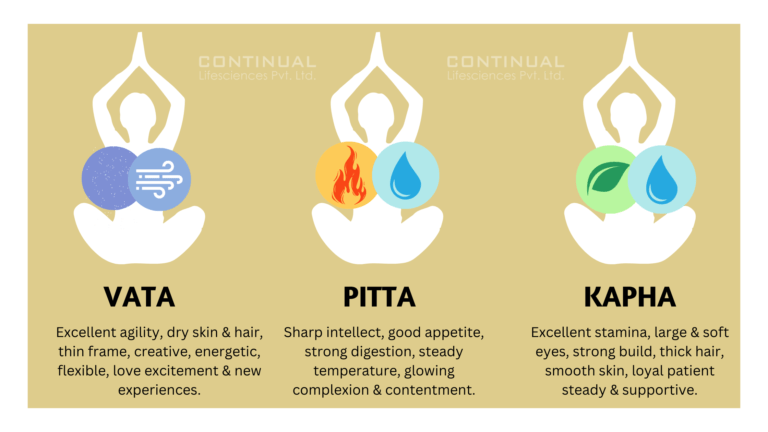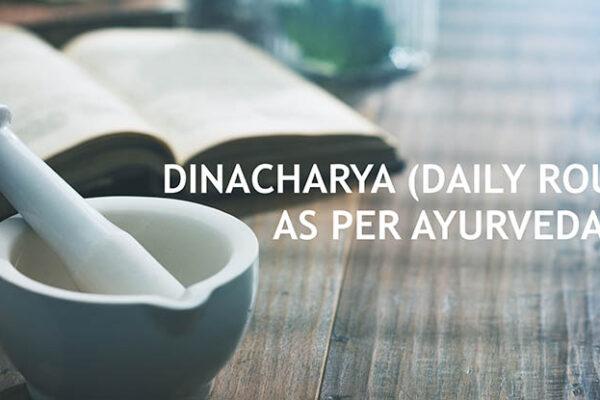Balancing the Elements: Exploring the concept of Doshas in Ayurveda for Holistic Well-being
Ayurveda, the ancient Indian system of medicine, views health as a state of balance in the body, mind and spirit. At the core of Ayurvedic philosophy are the three doshas—Vata, Pitta and Kapha—which represent fundamental energies governing all aspects of our being. By understanding your dosha constitution, you can tailor your lifestyle choices to promote harmony and well-being. In this blog, we delve into the intricacies of doshas, guide you in identifying your dominant dosha, and offer practical tips to pacify each dosha for optimal health.
The Three Doshas:
According to Ayurveda, each dosha is associated with specific elements, qualities and functions within the body:
a) Vata Dosha: Vata is primarily composed of the elements of ether (space) and air. It embodies qualities such as dryness, lightness, coldness, roughness and movement. Vata governs bodily functions related to circulation, respiration, elimination, and nervous system activity. When imbalanced, Vata can lead to symptoms such as anxiety, restlessness, dry skin, constipation and irregular digestion.
b) Pitta Dosha: Pitta consists of the elements of fire and water. It embodies qualities of heat, intensity, sharpness, lightness and transformation. Pitta governs metabolic processes, digestion, hormone balance, and Balancing the Elements: Exploring the concept of Doshas in Ayurveda for Holistic Well-being mental sharpness. Excess Pitta may manifest as irritability, anger, inflammation, heartburn, skin rashes and digestive disorders.
c) Kapha Dosha: Kapha is characterized by the elements of earth and water. It embodies qualities of heaviness, coolness, moistness, stability and lubrication. Kapha governs structural integrity, immunity, emotional stability and nourishment. When Kapha becomes imbalanced, it can lead to weight gain, congestion, lethargy, attachment and depression.
Identifying Your Dominant Dosha:
Determining your dominant dosha is essential for personalized Ayurvedic care. While consulting an Ayurvedic practitioner is recommended for a precise assessment, you can gain preliminary insights by observing your physical, mental and emotional characteristics. Ayurvedic texts such as the “Charaka Samhita” and the “Sushruta Samhita” provide detailed guidance on dosha identification.
a) Prakriti: Prakriti refers to your innate dosha constitution, representing your unique balance of the three doshas since birth. To assess your Prakriti, consider the following:
I. Physical Traits: Observe your body type, weight distribution, muscle tone, hair texture, skin condition and facial features. Vata-dominant individuals tend to be slim and have dry skin. Pitta-dominant individuals often have a moderate build and fair or reddish-toned skin. Kapha-dominant individuals usually have a solid build and smooth, oily skin.
II. Psychological Attributes: Reflect on your temperament, emotional tendencies, sleep patterns and preferences. Vata-dominant individuals tend to be creative, enthusiastic, and prone to anxiety. Pitta-dominant individuals are often ambitious, focused, and can be prone to anger. Kapha-dominant individuals are usually calm, compassionate, and may have a tendency towards attachment.
b) Vikriti: Vikriti refers to your current doshic imbalance, indicating which dosha(s) may be out of balance. Observing changes in the following areas can provide insights into your Vikriti:
I. Appetite and Digestion: Notice any variations in your appetite, digestion and bowel movements. Vata imbalance may cause irregular hunger and digestion. Pitta imbalance may lead to excessive hunger, hyperacidity or loose stools. Kapha imbalance may result in sluggish digestion and a tendency towards overeating. Balancing the Elements: Exploring the concept of Doshas in Ayurveda for Holistic Well-being
II. Energy Levels: Pay attention to your energy levels throughout the day. Vata imbalance may cause variable energy, with bursts of enthusiasm followed by fatigue. Pitta imbalance may manifest as excessive energy or a tendency towards burnout. Kapha imbalance may lead to lethargy and a lack of motivation.
III. Emotional State: Observe any shifts in your emotional well-being. Vata imbalance may lead to anxiety, fear and mood swings. Pitta imbalance may cause irritability, frustration and impatience. Kapha imbalance may result in emotional attachment, depression and resistance to change.

Pacifying Each Dosha:
To restore balance and pacify the doshas, Ayurveda offers specific lifestyle recommendations. Here are additional tips for pacifying each dosha:
a) Vata Pacification: – Follow a regular daily routine to establish stability and promote grounding. – Keep warm and maintain a nurturing environment. – Consume warm, cooked foods and favour sweet, sour and salty tastes. – Stay hydrated and sip warm herbal teas. Balancing the Elements: Exploring the concept of Doshas in Ayurveda for Holistic Well-being – Practice gentle, grounding exercises such as yoga, Tai Chi, and walking. – Prioritize relaxation, adequate sleep, and stress management techniques. – Use calming essential oils like lavender and sandalwood.
b) Pitta Pacification: – Stay cool and avoid excessive heat or direct sunlight. – Opt for cooling foods, including fresh fruits and vegetables, coconut water and cucumber. – Emphasize sweet, bitter and astringent tastes while reducing spicy, sour and salty foods. – Engage in calming activities like meditation, deep breathing exercises and swimming. – Cultivate a balanced work-play routine and avoid overexertion. – Practice moderation and avoid excessive competition or aggression. – Use cooling essential oils like rose and peppermint.
c) Kapha Pacification: – Stay active and incorporate regular exercise into your routine, focusing on cardiovascular activities and strength training. – Consume warm, light foods and favour pungent, bitter and astringent tastes. – Emphasize cooked vegetables, whole grains, legumes, and spices like ginger, black pepper and turmeric. – Engage in stimulating activities that promote mental and physical vigor. – Practice invigorating exercises such as dancing, jogging and aerobic workouts. – Cultivate a sense of adventure and embrace change. – Use stimulating essential oils like eucalyptus and citrus.
Understanding your dosha constitution and adopting Ayurvedic principles to pacify imbalances can lead to enhanced well-being and vitality. While the tips provided serve as a general framework, personalized guidance from an experienced Ayurvedic practitioner is crucial for a comprehensive understanding of your doshas and their impact on your health. Embrace Ayurveda’s wisdom, integrate its practices into your lifestyle, and begin on a transformative journey towards holistic wellness.
Curated by: Ms. Aditi Verma
Reviewed by: Dr. Darshan Dhage






